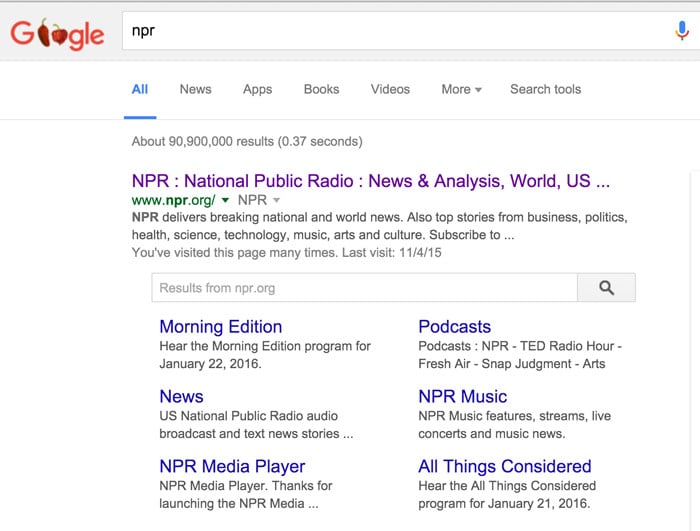Looking forward into 2016, one prediction is certain: Google will continue to update its algorithm, sometimes to the pleasure and sometimes to the dismay of website owners. And, when major shifts occur, as always, search marketing strategies will have to adapt.
Today, however, your firm is competing for elusive, difficult to obtain and extremely valuable placement in the first page of search results. According to an Advanced Web Ranking study, the average click through rate for page one listings is 71 percent. This drops to 5.5 percent for results on pages two and three.
While search marketing will always be an ongoing process, there are items your firm can address now to help build value in the eyes of search engines. Here are ten things search engines are looking for in well-performing pages.
1. Authority
Search engines want to provide quality results for searchers, and one way to do so is to rank trusted, authoritative websites highly. A website can build authority by demonstrating its usefulness to visitors and showing that others within its industry respect and have confidence in the information it publishes.
Google, in particular is looking for a high level of Expertise, Authoritativeness and Trustworthiness, or E-A-T. In order to establish a website's level of authority, Google considers many factors, such as reviews, recommendations from industry colleagues, press mentions, awards, acknowledgments from professional organizations, and comments or forum posts on large review sites.
Pages on attorneys websites are held to a high standard since they involve matters of law. Your content should be up-to-date and factual, well-edited and clearly written by someone who has knowledge of legal issues.
Most search engines know that the owners of a website are going to post glowing reviews and positive information on their own pages, over which they have control. This is why Google looks for off-site signals like comments, reviews and articles about the firm to validate on-site claims. It's in your firm's interest to get others talking about you. References from other high-authority sites, like schools and professional associations, provide the signals search engines are looking for.
2. Quality content
Google has not been shy about expressing its desire for websites to publish well-written, helpful, regularly-updated and informative content. Its philosophy is that all pages should exist to help users in some way. Google Panda, originally released in 2011 to lower the rankings of pages with poor-quality or thin content, is now a part of their core algorithm. And Google's Webmaster Guidelines contain several sections dedicated to describing quality content.
Primarily, Google wants publishers to forget about search engines and write for people. Keyword stuffing, poor editing, pages with little original content or pages about a topic about which the author has little expertise are all examples of what Google considers low-quality content. Pages should be factual, unique, and written with authority. Some of the best pages will approach a topic from a different point of view, or provide information that is not easily available on other, similar sites.
In Google's own words, a good question to ask is, "Does this help my users? Would I do this if search engines didn't exist?"
3. Facts about your firm and attorneys
Search engines are looking for information about the owner of a site, in part to help affirm authority and trustworthiness. This includes clearly-placed contact information as well as information about the attorneys and staff working at the firm.
Every attorney website should contain a thorough about page that details the firm's history and philosophy, as well as current and maintained attorney bio pages. Bio pages should contain personal and professional information, and links to articles, videos and reviews, all of which can help prove expertise and build authority for the site as a whole.
In addition to building trust, publishing contact and other firm information helps provide a good user experience. Google wants visitors to be able to quickly contact and research the website owner.
4. Mobile-friendliness
Google recognizes (among others) two key things about the nature of the internet and the ways users interact with it:
- · Users are increasingly using mobile devices to search, and mobile search volume has eclipsed desktop search volume in the United States.
- · A user's device can drastically affect that user's online experience. Particularly, a mobile device by its nature provides challenges in terms of readability and navigation that desktop users may not face.
Because of this reality, Google is using its weight to push for a wholly mobile-friendly web. It has publicly stated its preference for responsive design, but any page that is deliberately designed to display optimally on a smartphone or tablet is considered to be mobile-friendly.
The most effective mobile pages will be consciously built for each device, with users in mind. Consider font-size, button size and ease of navigation for smaller screens. Make phone numbers clickable. Reduce the size of page elements to increase load speed. Research the actions your mobile users take most frequently and optimize pages to make those actions effortless.
Google offers a Mobile-Friendly Test tool, which firms can use to evaluate their pages' mobile performance.
5. User Experience
In addition to looking for quality content, search engines also consider how easy or difficult a page is to use. When someone clicks on a search result, he or she should be able to quickly locate desired information and navigate to relevant pages smoothly.
All elements on a webpage come together to create a positive or negative experience, and a good user experience will encourage visitors to stay on a site. From a design perspective, text should be easy to read and well-spaced, and relevant information should be grouped together with graphics into easily digestible pieces. Navigation should be intuitive, with appropriate internal links and content recommendations to keep visitors engaged. Technically, the site should be error-free and not use out-of-date software, like Flash, that cannot be rendered by mobile browsers.
From a user perspective, simplicity and ease of use are key.
6. Load speed
Google considers load speed to be one aspect of a positive (or negative) user experience. Google's Webmaster Guidelines flatly state that, “Fast sites increase user satisfaction and improve the overall quality of the web.”
This remark is supported by search data. According to Searchmetrics' 2015 Mobile Ranking Factors report, pages that load more quickly rank better in search results. A difference of fractions of a second can be the difference between being in the top ten or sliding to page two.
Google provides a speed test that developers can use to evaluate their own pages. Any score above 80 is considered a passing grade — a number that is surprisingly difficult to achieve. If you find that your pages are performing poorly, you can try implementing Google's recommendations, which are listed with your score.
7. Basic markup
Metadata is not the SEO magic bullet it used to be, but it is still important to provide this information to search engines and users. Metadata is specified by using meta tags in the header of a website. If you use a content management system like WordPress, metadata can be entered in your website's settings.
Meta tags allow you to provide keyword, author and description information, which can be seen by search engines and users. The description is the brief paragraph users see immediately below your listing in search results. Your description will not affect your raking placement, but a good description can encourage searchers to click on your listing. Consider placing a call to action in your description tag.
Another important piece of header markup is the title tag. The title tag is required in all HTML documents, and it determines what language will display in the browser toolbar, what title will be used for bookmarks, and what title will display in search results.
For example, npr.org uses the title:
<title>NPR : National Public Radio : News & Analysis, World, US, Music & Arts : NPR</title>
and its search result appears as:

In addition to basic meta and title data, your code should do its best to define the structure of the site and tell search engines what information is most important by using header and section tags.
Images should all have alt tags, which provide information about the image. If you hover over an image, and a little box pops up next to your cursor with a few words about it, those words are defined by an alt tag. Alt tags are displayed when a browser cannot load an image, and they are what is read when a user with vision impairment uses a screen reader. Below is an example of an alt tag in action.

8. Site maintenance and upkeep
Google holds different types of sites to different upkeep standards. For example, a family-run site with the purpose of displaying vacation photos may only be updated once every year or so. This is appropriate for that type of site.
An attorney website, however, run by a professional firm, that contains information about the law is held to a much higher standard. Information on all pages must be current and accurate. Blogs should be updated regularly — at least once a month. Webmasters should run regular tests to ensure all links are working and the website's code is error-free. Google wants to know that care is being taken to provide timely, valid, useful content.
9. Local cues (local SEO)
Google wants not only to provide the best results generally, but also to provide the best results for any given moment in time. A user searching for “Zeitgeist” for example may be looking for information about the school of thought or the film series. Users in San Francisco, however, may also be looking for the popular bar, Zeitgeist, in the Mission.
It is Google's continued aim to correctly guess which meaning of a term a user is interested in at that exact moment. This is why local data is so important. If someone is searching for a general keyword but is physically located near your firm, Google needs to know this. Every firm should have a Google My Business profile that contains accurate name, address and phone (NAP) data, as well as office hours. And, be vigilant to ensure your NAP information is exactly the same everywhere. If Google sees inconsistent NAP listings it will consider that to be a reason not to trust your firm.
10. Quality backlinks
According to a recent Legal Marketing Lab study, the top ranking pages for competitive practice area terms in large metropolitan areas do not necessarily have more links than lower-ranking pages. In 54 percent of the searches performed, the second-ranked site actually had more links.
While many of the top ranked sites did not necessarily have the largest link portfolio, they did share another characteristic: link quality. These pages received fewer links from free directories, which are easy to get, and more links from government and education-oriented websites. These link portfolios also tended to be more diverse.
This data is in line with Google's overall emphasis on content quality and its attempts to move away from link quantity as a top ranking factor.

